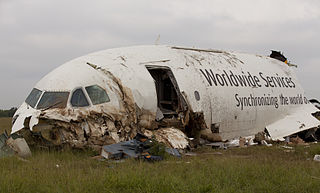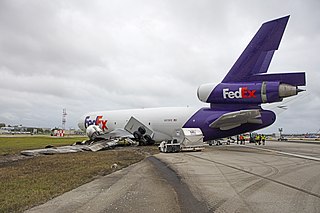
Turkish Airlines Flight 981 (TK981/THY981) was a scheduled flight from Istanbul Yeşilköy Airport to London Heathrow Airport, with an intermediate stop at Orly Airport in Paris. On 3 March 1974, the McDonnell Douglas DC-10 operating the flight crashed into the Ermenonville Forest, outside Paris, killing all 346 people on board. The crash was also known as the Ermenonville air disaster. Flight 981 was the deadliest plane crash in aviation history until 27 March 1977, when 583 people perished in the collision of two Boeing 747s in Tenerife. It remained the deadliest single-aircraft accident until the crash of Japan Airlines Flight 123 on 12 August 1985, and the deadliest aviation accident without survivors until the Charkhi Dadri mid-air collision on 12 November 1996. It remains the deadliest single-aircraft accident without survivors, the first fatal hull loss and the deadliest crash involving the McDonnell Douglas DC-10, the sixth deadliest aviation disaster altogether, and the deadliest aviation accident to occur in France. It is also the deadliest aviation incident that did not involve a Boeing 747.

Delta Air Lines Flight 1141 was a scheduled domestic passenger flight between Dallas/Fort Worth, Texas and Salt Lake City, Utah. On August 31, 1988, the flight, using a Boeing 727-200 series aircraft, crashed during takeoff, resulting in 14 deaths and 76 injuries of the 108 on board.

American Airlines Flight 96 (AA96/AAL96) was a regular domestic flight operated by American Airlines from Los Angeles to New York via Detroit and Buffalo. On June 12, 1972, the left rear cargo door of the McDonnell Douglas DC-10-10 operating the flight blew open and broke off en route between Detroit and Buffalo above Windsor, Ontario; the accident is thus sometimes referred to as the Windsor incident, although according to the NTSB it is an accident, not an incident.

Midwest Express Airlines Flight 105 was a scheduled domestic passenger flight that crashed into an open field in Milwaukee, Wisconsin shortly after taking off from General Mitchell International Airport on September 6, 1985. The airplane, a Douglas DC-9, was carrying 31 passengers and crew. None of them survived the crash.

Trans World Airlines (TWA) Flight 159 was a regularly scheduled passenger flight from New York City to Los Angeles, California, with a stopover in Cincinnati/Northern Kentucky International Airport, Kentucky, that crashed after an aborted takeoff from Cincinnati on November 6, 1967. The Boeing 707 attempted to abort takeoff when the copilot became concerned that the aircraft had collided with a disabled DC-9 on the runway. The aircraft overran the runway, struck an embankment and caught fire. One passenger died as a result of the accident.

The 1990 Wayne County Airport runway collision involved the collision of two Northwest Airlines jetliners at Detroit Metropolitan Wayne County Airport on December 3, 1990. Flight 1482, a scheduled Douglas DC-9-14 operating from Detroit to Pittsburgh International Airport, taxied by mistake onto an active runway in dense fog and was hit by a departing Boeing 727 operating as Flight 299 to Memphis International Airport. One member of the crew and seven passengers of the DC-9 were killed.

National Airlines Flight 102 (N8102/NCR102) was a cargo flight operated by National Airlines between Camp Shorabak in Afghanistan and Al Maktoum Airport in Dubai, with a refueling stop at Bagram Airfield, Afghanistan. On 29 April 2013, the Boeing 747-400 operating the flight crashed moments after taking off from Bagram, killing all seven people on board.

UPS Airlines Flight 1354 (5X1354/UPS1354) was a scheduled cargo flight from Louisville, Kentucky, to Birmingham, Alabama. On August 14, 2013, the Airbus A300 flying the route crashed and burst into flames short of the runway on approach to Birmingham–Shuttlesworth International Airport. Both pilots were pronounced dead at the scene of the crash. They were the only people aboard the aircraft. It was the second fatal air crash for UPS Airlines.

On October 28, 2016, FedEx Express Flight 910, a McDonnell Douglas MD-10-10F flying from Memphis International Airport to Fort Lauderdale–Hollywood International Airport was involved in a runway skid after a landing gear collapse, which resulted in a fire completely destroying the left engine and wing. Two crew members, the only people on board, were unharmed.

Japan Air Lines Cargo Flight 1045 was a charter flight on January 13, 1977, from Grant County, Washington, United States, to Tokyo, Japan, with a stopover in Anchorage, Alaska, United States. The flight crashed during the initial climb phase, shortly after takeoff from Anchorage, in part because the flight captain, Hugh L. Marsh, was intoxicated as shown by a blood alcohol level of 0.29; the co-pilot and the other crew were not impaired. All of those on board, including three flight crew members and two cattle handlers, were killed in the crash.

Emery Worldwide Airlines Flight 17 was a regularly scheduled domestic cargo flight, flying from Reno to Dayton with an intermediate stopover at Rancho Cordova. On February 16, 2000, the DC-8 operating the flight crashed onto an automobile salvage yard shortly after taking off from Sacramento Mather Airport, resulting in the deaths of all three crew members on board. The crew reported control problems during takeoff and attempted unsuccessfully to return to Mather airport.

Pan Am Flight 799 was an international cargo flight from Los Angeles International Airport to Cam Ranh Airport in South Vietnam that crashed on December 26, 1968, near Anchorage, Alaska. The aircraft involved was a Boeing 707-321C aircraft operated by Pan American World Airways. All three crew members died in the crash.

Atlas Air Flight 3591 was a scheduled domestic cargo flight under the Amazon Air banner between Miami International Airport and George Bush Intercontinental Airport in Houston. On February 23, 2019, the Boeing 767-375ER(BCF) used for this flight crashed into Trinity Bay during approach into Houston, killing the two crew members and a single passenger on board. The accident occurred near Anahuac, Texas, east of Houston, shortly before 12:45 CST (18:45 UTC). This was the first fatal crash of a Boeing 767 freighter.

Air Transport International Flight 805 was a regularly scheduled domestic cargo flight from Seattle to Toledo operated by Burlington Air Express. On February 15, 1992, the Douglas DC-8 operating the flight crashed during a second go-around attempt at Toledo Express Airport, killing all four people on board. The National Transportation Safety Board (NTSB) determined that the accident was caused by pilot error due to the aircraft's control not being maintained.

Ryan International Airlines Flight 590 was a cargo flight carrying mail for the United States Postal Service from Greater Buffalo International Airport (BUF) in Buffalo, New York, to Indianapolis International Airport (IND) in Indiana, with a stopover at Cleveland Hopkins International Airport (CLE) in Cleveland, Ohio. On February 17, 1991, the McDonnell Douglas DC-9-15RC operating the flight crashed on takeoff from Cleveland during icing conditions. Both pilots, the aircraft's only occupants, were killed. The National Transportation Safety Board (NTSB) determined that the causes of the crash were the flight crew failing to deice their aircraft, and the inexperience of the Federal Aviation Administration (FAA), McDonnell Douglas, and Ryan International Airlines with icing condition on DC-9-10 aircraft.

Evergreen International Airlines Flight 17 (4U17/EIA17) was a cargo flight operated by Evergreen International Airlines and flown by a McDonnell Douglas DC-9. On March 18, 1989, the flight's planned route was scheduled to take it from Kelly Air Force Base to Tinker Air Force Base, with a stop at Carswell Air Force Base in Fort Worth, Texas. The two pilots were the only occupants on board. Immediately after takeoff from Carswell, the aircraft's main cargo door opened, the crew lost control of the aircraft and it subsequently crashed while attempting an emergency landing, killing both pilots.

Air Transport International Flight 782 was a ferry flight from Kansas City International Airport in Missouri to Westover Metropolitan Airport in Springfield, Massachusetts using a Douglas DC-8-63 with one of its 4 engines inoperative. On February 16, 1995, the aircraft failed to takeoff from Kansas City, went off the runway, and crashed. All three flight crew members, the only occupants on board, were killed. The cause was deemed to be improper training, which resulted in the crew failing to understand a three-engine takeoff procedure. In addition, the Federal Aviation Agency (FAA)'s oversight of rest regulations and the airline were both poor.

Transair Flight 810 was a Boeing 737-200 converted freighter aircraft, owned and operated by Rhoades Aviation under the Transair trade name, on a short cargo flight en route from Honolulu International Airport to Kahului Airport on the neighboring Hawaiian island of Maui. Immediately after an early morning takeoff on July 2, 2021, one of its two Pratt & Whitney JT8D turbofan engines faltered, and the first officer, who was flying the aircraft, reduced power to both. The two pilots—who were the only aircraft occupants—began executing the Engine Failure or Shutdown checklist, but became preoccupied with talking to air traffic control (ATC) and performing other flying tasks, and never reached the section of the checklist where the failing engine was to be positively identified and shut down. The captain assumed control but misidentified the failing engine, increased power to that engine, and did not increase power to the other, properly functioning engine. Convinced that neither engine was working properly and unable to maintain altitude with one engine faltering and the other idling, the pilots ditched off the coast of Oahu about 11 minutes into the flight.


















